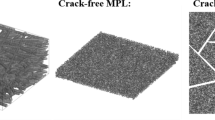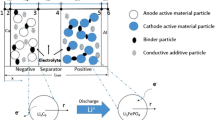Abstract
According to the structure and working characteristics of zinc-nickel single-flow battery stack cell, this paper proposes a pore-size analysis model for internal mass transfer and chemical reaction of positive electrode to describe liquid-phase mass transfer, solid-phase mass transfer, and electrochemical reaction. The lattice Boltzmann method was used to simulate the steady-state reaction under constant current charging. The distribution of the concentration of liquid-phase reaction ions, the proton concentration of the solid phase, and the reaction current density were determined. The influence of electrolyte flow velocity and constant current charge-current density on the electrode reaction was further explored.














Similar content being viewed by others
Abbreviations
- j Ni :
-
Reaction current on the surface of the positive solid phase
- i Ni, ref :
-
Positive electrode exchange current density
- \( {C}^{{\mathrm{OH}}^{-}} \) :
-
Hydroxide concentration
- \( {C}_{\mathrm{ref}}^{{\mathrm{OH}}^{-}} \) :
-
Positive electrode hydroxide reference concentration
- \( {C}^{{\mathrm{H}}^{+}} \) :
-
Proton concentration
- \( {C}_{\mathrm{ref}}^{{\mathrm{H}}^{+}} \) :
-
Positive reference proton concentration
- \( {C}_{\mathrm{max}}^{{\mathrm{H}}^{+}} \) :
-
Positive proton maximum concentration
- a 1 :
-
Cathode transfer coefficient
- η 1 :
-
Positive reaction overpotential
- R :
-
Molar gas constant
- F :
-
Faraday constant
- T :
-
Temperature
- f i :
-
Particle distribution function
- Δt :
-
Time step
- Δx :
-
Lattice length
- ω :
-
Relaxation frequency
- τ :
-
Relaxation factor
- υ :
-
Fluid viscosity
- \( {f}_{\mathrm{i}}^{\mathrm{eq}} \) :
-
Equilibrium distribution function
- c i :
-
Discrete speed
- \( \overrightarrow{u} \) :
-
Convective velocity vector
- c k :
-
Unit vector along the flow direction
- c s :
-
Lattice acoustic velocity
- w i :
-
Weight factor
- g i :
-
OH− concentration distribution function
- \( {g}_{\mathrm{i}}^{\mathrm{eq}} \) :
-
Equilibrium distribution function of OH−mass transfer process
- φ(x, t):
-
OH− concentration in LBM model
- h i :
-
H+ concentration distribution function
- \( {h}_i^{\mathrm{eq}} \) :
-
Equilibrium distribution function of H+ mass transfer
- ϕ(x, t):
-
H+ concentration in LBM model
- I :
-
Current density
- ρ :
-
Fluid density
- BGK:
-
Single relaxation model (Boltzmann-BGK equation)
- D2Q9:
-
2D and 9 discrete speeds
- \( {D}^{{\mathrm{OH}}^{-}} \) :
-
OH− diffusion coefficient
- \( {D}^{{\mathrm{H}}^{+}} \) :
-
H+ diffusion coefficient
References
Cheng J, Wen YH, Cao GP (2011) Influence of zinc ions in electrolytes on the stability of nickel oxide electrodes for single flow zinc–nickel batteries. J Power Sources 196:1589–1592
Qiu G, Joshi AS, Dennison CR (2012) 3-D pore-scale resolved model for coupled species/charge/fluid transport in a vanadium redox flow battery. Electrochim Acta 64:46–64
Li Q, Luo KH, Kang QJ (2016) Lattice Boltzmann methods for multiphase flow and phase-change heat transfer. Prog Energy Combust Sci 52:62–105
Chen L, Ruan HB, Tao WB (2010) Electrochemical reaction of cathode flow mass transfer in PEMFC simulated by LBM. J Eng Thermophys V31:1383–1388
Xu H (2013) Lattice Boltzmann simulation of SOFC multi component mass transfer process. J Eng Thermophys 34:1711–1715
Chen W, Jiang FM (2016) LBM study on the effect of PTFE content and distribution on gas-liquid two-phase flow in PEMFC gas diffusion layer. J Eng Thermophys V37:1475–1483
Liu J, Wang Y (2015) Preliminary study of high energy density Zn/Ni flow batteries. J Power Sources 294:574–579
Yao S, Liao P, Xiao M (2016) Modeling and simulation of the zinc-nickel single flow batteries based on MATLAB/Simulink. AIP Adv 6:125–302
Yao S, Liao P, Xiao M (2017) Study on electrode potential of zinc nickel single-flow battery during charge. Energies 10:1101
Parasuraman A, Lim TM, Menictas C (2013) Review of material research and development for vanadium redox flow battery applications. Electrochim Acta 101:27–40
Gu WB, Wang CY (2000) Thermal-electrochemical modeling of battery systems. J Electrochem Soc 147:2910–2922
Xu H, Dang Z, Bai BF (2012) Numerical simulation of multi species mass transfer in a SOFC electrodes layer using lattice Boltzmann method. J Fuel Cell Sci Technol 9:327–334
Shikazono N, Kanno D, Matsuzaki K (2010) Numerical assessment of SOFC anode polarization based on three-dimensional model microstructure reconstructed from FIB-SEM images. J Electrochem Soc 157:B665–B672
Qiu G, Dennison CR, Knehr KW (2012) Pore-scale analysis of effects of electrode morphology and electrolyte flow conditions on performance of vanadium redox flow batteries. J Power Sources 219:223–234
Chen L, He YL, Tao WQ (2017) Pore-scale study of multiphase reactive transport in fibrous electrodes of vanadium redox flow batteries. Electrochim Acta 248:425–439
Wang M, Wang JK, Pan N, Chen SY (2007) Mesoscopic predictions of the effective thermal conductivity for microscale random porous media. Phys Rev E 75:036702–036712
Wang M, Wang JK, Pan N, Chen SY, He JH (2007) Three-dimensional effect on the effective thermal conductivity of porous med. J Phys D Appl Phys 40:260–265
Srinivasan V, Weidner JW, White RE (2000) Mathematical models of the nickel hydroxide active material. J Solid State Electrochem 4:367–382
Hu SW, Zhu YX, You R (2010) Diffusion simulation of chloride ions in reinforced concrete structures under external electric field. J Waterway Eng 8:7–11
Xu A, Wei S, Zhao T (2017) Lattice Boltzmann modeling of transport phenomena in fuel cells and flow batteries. Acta Mech Sinica 33:1–20
Fu YH, Bai L, Luo KH (2017) Modeling mass transfer and reaction of dilute solutes in a ternary phase system by the lattice Boltzmann method. Phys Rev E 95:043304
Yao SG, Zhao YH, Sun XF, Zhao Q, Cheng J (2019) A dynamic model for discharge research of zinc-nickel single flow battery. Electrochim Acta 307:573–581
Yao SG, Zhao YH, Sun XF, Ding DP, Cheng J (2019) Numerical studies of cell stack for zinc-nickel single flow battery. Int J Electrochem Sci 14:2160–2174
Funding
This paper was supported by the National Natural Science Foundation Project of China (No. 51776092).
Author information
Authors and Affiliations
Corresponding author
Additional information
Publisher’s note
Springer Nature remains neutral with regard to jurisdictional claims in published maps and institutional affiliations.
Rights and permissions
About this article
Cite this article
Yao, S., Xu, L., Li, Y. et al. Pore-scale simulation of internal reaction mechanism of positive electrode for zinc-nickel single-flow battery. J Solid State Electrochem 24, 915–928 (2020). https://doi.org/10.1007/s10008-020-04536-y
Received:
Revised:
Accepted:
Published:
Issue Date:
DOI: https://doi.org/10.1007/s10008-020-04536-y




